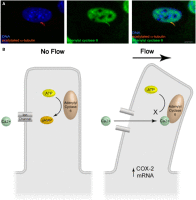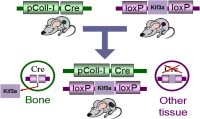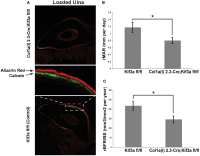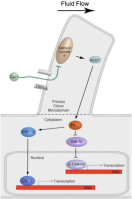The primary cilium as a novel extracellular sensor in bone
- PMID: 22707948
- PMCID: PMC3374377
- DOI: 10.3389/fendo.2012.00075
The primary cilium as a novel extracellular sensor in bone
Abstract
Mechanically induced adaptation of bone is required to maintain a healthy skeleton and defects in this process can lead to dramatic changes in bone mass, resulting in bone diseases such as osteoporosis. Therefore, understanding how this process occurs could yield novel therapeutics to treat diseases of excessive bone loss or formation. Over the past decade the primary cilium has emerged as a novel extracellular sensor in bone, being required to transduce changes in the extracellular mechanical environment into biochemical responses regulating bone adaptation. In this review, we introduce the primary cilium as a novel extracellular sensor in bone; discuss the in vitro and in vivo findings of primary cilia based sensing in bone; explore the role of the primary cilium in regulating stem cell osteogenic fate commitment and finish with future directions of research and possible development of cilia targeting therapeutics to treat bone diseases.
Keywords: bone; fluid flow; mechanotransduction; osteocyte; primary cilium; stem cell.
Figures





Similar articles
-
Primary cilia-mediated mechanotransduction in human mesenchymal stem cells.Stem Cells. 2012 Nov;30(11):2561-70. doi: 10.1002/stem.1235. Stem Cells. 2012. PMID: 22969057 Free PMC article.
-
Osteocytes and Primary Cilia.Curr Osteoporos Rep. 2023 Dec;21(6):719-730. doi: 10.1007/s11914-023-00819-1. Epub 2023 Sep 8. Curr Osteoporos Rep. 2023. PMID: 37682373 Free PMC article. Review.
-
Bone cell mechanosensation of fluid flow stimulation: a fluid-structure interaction model characterising the role integrin attachments and primary cilia.Biomech Model Mechanobiol. 2015 Aug;14(4):703-18. doi: 10.1007/s10237-014-0631-3. Epub 2014 Nov 16. Biomech Model Mechanobiol. 2015. PMID: 25399300
-
The mechanics of the primary cilium: an intricate structure with complex function.J Biomech. 2012 Jan 3;45(1):17-26. doi: 10.1016/j.jbiomech.2011.08.008. Epub 2011 Sep 6. J Biomech. 2012. PMID: 21899847 Free PMC article. Review.
-
The primary cilium functions as a mechanical and calcium signaling nexus.Cilia. 2015 May 29;4:7. doi: 10.1186/s13630-015-0016-y. eCollection 2015. Cilia. 2015. PMID: 26029358 Free PMC article.
Cited by
-
Osteocyte Mechanobiology.Curr Osteoporos Rep. 2017 Aug;15(4):318-325. doi: 10.1007/s11914-017-0373-0. Curr Osteoporos Rep. 2017. PMID: 28612339 Free PMC article. Review.
-
Fluid shear stress induces upregulation of COX-2 and PGI2 release in endothelial cells via a pathway involving PECAM-1, PI3K, FAK, and p38.Am J Physiol Heart Circ Physiol. 2017 Mar 1;312(3):H485-H500. doi: 10.1152/ajpheart.00035.2016. Epub 2016 Dec 23. Am J Physiol Heart Circ Physiol. 2017. PMID: 28011582 Free PMC article.
-
The Impact of the Extracellular Matrix Environment on Sost Expression by the MLO-Y4 Osteocyte Cell Line.Bioengineering (Basel). 2022 Jan 13;9(1):35. doi: 10.3390/bioengineering9010035. Bioengineering (Basel). 2022. PMID: 35049744 Free PMC article.
-
Estrogen withdrawal alters cytoskeletal and primary ciliary dynamics resulting in increased Hedgehog and osteoclastogenic paracrine signalling in osteocytes.Sci Rep. 2021 Apr 29;11(1):9272. doi: 10.1038/s41598-021-88633-6. Sci Rep. 2021. PMID: 33927279 Free PMC article.
-
Convergence of Calcium Channel Regulation and Mechanotransduction in Skeletal Regenerative Biomaterial Design.Adv Healthc Mater. 2023 Oct;12(27):e2301081. doi: 10.1002/adhm.202301081. Epub 2023 Jul 16. Adv Healthc Mater. 2023. PMID: 37380172 Free PMC article. Review.
References
Grants and funding
LinkOut - more resources
Full Text Sources
Miscellaneous

